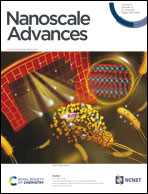Ultrafast high-capacity capture and release of uranium by a light-switchable nanotextured surface†
Abstract
Nuclear power is growing in demand as a promising sustainable energy source, its most prevalent source being uranium salts. The resulting processing and transportation of uranium raise concerns regarding the environmental impact and risks for human health. Close proximity to uranium mines puts populations at higher risk for exposure due to elevated uranium concentrations. As the main form of uranium in aqueous solutions, uranyl (UO22+) has been the focus of many methods of uranium sieving; most fall short by being time-consuming or lacking a retrieval mechanism for the captured uranium. Here, we demonstrate the ultrafast and selective uranyl-capturing properties of aptamer-modified branched silicon nanopillar (BSiNP) arrays. Our nanostructured surfaces demonstrate an ultrahigh surface area modified with a uranyl-specific DNA aptamer, allowing for high uranyl-capturing capacity, reaching up to 550 mg g−1. Uranyl capture is followed by the activation of a covalently bonded photoacid, causing a light-triggerable, ultrafast release. This capture-and-release cycle results in the collection of over 70% of the uranium found in the original samples within less than one hour.



 Please wait while we load your content...
Please wait while we load your content...